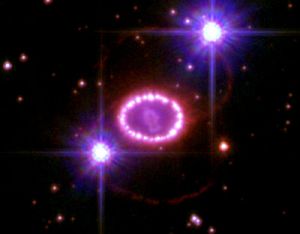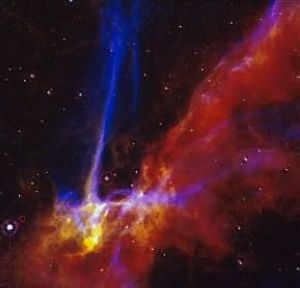Star Evolution:
We Are Made of Stardust!
Can it really be chance that in the process of star evolution, supernovas spew organic molecules—the very molecules we are made of—across vast reaches of space?
Can it really be chance that we are, quite literally, made of stardust?
Star Evolution:
The Handiwork of God
Ice floats.
 Unnamed supernova remnant flanked by brilliant stars | Photo by NASA
Unnamed supernova remnant flanked by brilliant stars | Photo by NASAMany of us don't think about that, but it's very unusual. Almost all other substances become denser, and thus heavier, when they freeze (become solid).
Not ice. Due to the chemical bonds that hold the hydrogen atoms together, water becomes less dense when it drops below 39° fahrenheit. By the time it freezes into ice at 32°, it is about 9% less dense than liquid water and so, it floats.
The result is that lakes and rivers freeze from the top down, creating an insulating layer of ice that prevents them from freezing solid and killing everything living in them.
Christians have argued for centuries that this unique property of water is an evidence of design, of a Creator that loves us and is at work in creation.
It's not right that we appeal to that unique feature of nature, but we ignore the just as amazing fact that stellar evolution produces the molecules we are made of!
Star Evolution:
How Stars Work
In Nuclear fusion, two or more atoms are combined into one, producing large amounts of energy. Our sun right now is combining two hydrogen atoms into one helium atom to warm our earth.
Nuclear fission is the splitting of atoms. The atom bomb that the US dropped on Japan used fission. Large atoms, like Uranium, are split in two releasing vast amounts of energy. The sun uses nuclear fusion, which is the combining of atoms. When small atoms are combined, or fused, the power released is far greater than that produced in fission. That is why an H-bomb is more powerful than an A-bomb.
Not all of a star is in nuclear fusion. That would not be a star; that would be a bomb. We'll read about how stars turn into very big bombs in a moment.
The fusion goes on only deep within the core. The corona, the outer part of a star is heated by the nuclear reactions going on in the core.
Virtually all the energy we use on earth comes from the sun. Even the energy we use from oil and coal is just solar energy stored by plants that lived and died millions of years ago. That is why oil and coal are called fossil fuels.
The sun also evaporates water to produce rain that makes our rivers flow, so dam power comes from the sun. It heats water and air to produce wind, so wind power comes from the sun as well.
Only geothermal, nuclear, and tidal energy are not produced by the sun.
Within several billion years our sun will run out of hydrogen. At that point in its stellar evolution, it will begin to combine three helium atoms into one carbon atom (at which time it will expand and consume us). Because our sun is just an average-sized star, it will burn out in that stage.
Not the largest stars. They continue far past carbon.
Star Evolution:
Large Stars
The largest stars, as they exhaust their supply of helium, will begin fusing carbon into larger elements. This process continues through several stages of stellar evolution, culminating in the fusion of silicon into nickel.
The interesting thing about this is that when elements larger than iron (nickel is two protons larger than iron) are fused, no energy is released. Massive amounts of energy are released when hydrogen is fused into helium, but when nickel is produced, no energy is released.
 Fusion shells of a large star
Fusion shells of a large starA star that reaches this stage of evolution has fusion going on in several layers. Each layer of fusion holds up the layers above it with the energy it produces.
The center, however, where nickel is being fused, is not producing energy. Fortunately, for the star, that nickel is radioactive, and it's decaying into iron. That decay produces energy, just enough to keep the star stable.
Unfortunately for the star, that can't continue forever. In fact, scientists say this last stage of large star evolution continues for just a few days.
Star Evolution:
Supernovas and Creation
 The Cygnus Loop, remnant of a supernova
The Cygnus Loop, remnant of a supernovaPhoto by NASA
The core suddenly collapses. The outer layers fall into the core at speeds reaching 45,000 miles per second. Wow!
That kind of collapse and compression produces massive amounts of heat.
At this point the details are very complicated (but interesting!), involving things like gamma rays reducing the iron in the core to neutrons and neutrinos, a neutron core being formed, and energy being released and absorbed through the layers of the star.
The general results of large star evolution are not complicated at all. The star blows up with a really big explosion!
How Big?
Temperatures in the core reach 6,000 times the heat of our sun, or about 100 billion degrees. The shock wave can carry on for 200 years, and it can take 10,000 years for the material ejected to cool to the temperature of surrounding materials.
Some shock waves are so big that they compress surrounding hydrogen clouds, creating instant stars.
NASA explains what happens then:
Because nuclear fusion reactions that make elements heavier than iron require more energy than they give off, such reactions do not occur under stable conditions that occur in stars. Supernovae, on the other hand, are not stable, so they can make these heavy elements beyond iron.
Simply put, the explosion produces all the heavy elements "that make up stars, planets, and everything on earth …
" … including ourselves."
As Christians, can we believe that's an accident?
The heavens declare the glory of God,
And the firmament shows his handiwork.
Day to day utters speech,
And night to night declares knowledge.
They have no speech or language;
Their voice is not heard,
But their sound has gone throughout the earth
And their words to the end of the world.
Return to Examples of Evolution